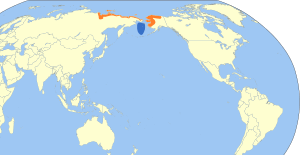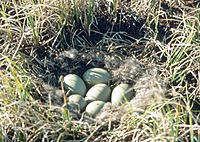Spectacled eider facts for kids
Quick facts for kids Spectacled eider |
|
|---|---|
 |
|
| Male (front) and female (rear) | |
| Conservation status | |
| Scientific classification | |
| Genus: |
Somateria
|
| Species: |
fischeri
|
 |
|
The spectacled eider (pronounced EYE-der) is a large sea duck. It lives and breeds along the coasts of Alaska and northeastern Siberia.
This special duck gets its name from the big, round white patches around its eyes. These patches look a lot like eyeglasses! The spectacled eider is a bit smaller than the common eider. It measures about 52–57 cm (20–22 inches) long.
Male spectacled eiders are easy to spot. They have a black body and a white back. Their head is a cool yellow-green color. The male's call is a soft, low sound. Female spectacled eiders are a rich brown color. They also have paler "goggles" around their eyes. Young birds and adult males in their non-breeding season look similar to the female.
This bird's scientific name, Somateria fischeri, honors a German scientist named Johann Fischer von Waldheim.
Contents
Where Do Spectacled Eiders Live?
Spectacled eiders are found along the coast of Alaska. They also live in eastern Russia and the Bering Sea. There are two groups that breed in Alaska. One large group breeds in Russia.
In the past, many more spectacled eiders nested in Alaska. Today, the Russian population is much bigger. About 3,000 to 4,000 pairs currently nest in the United States.
These ducks change their feathers, a process called molting, at sea. They do this anywhere from 2 to 45 kilometers from shore. They are usually found north of 63°N latitude. For a long time, no one knew where they spent their winters. Then, in 1995, scientists used satellite tracking. This helped them discover the ducks' winter homes in the Bering Sea.
Why Are Spectacled Eiders Protected?
In 1993, the United States listed the spectacled eider as a "Threatened" species. This means it needs special protection under the U.S. Endangered Species Act. However, the IUCN Red List, which tracks species worldwide, calls it "Least Concern." This is because the duck's range and population trends don't meet their specific rules for being more at risk.
The U.S. Fish and Wildlife Service listed the duck as Threatened. This was because the number of breeding pairs in Alaska dropped by more than 96%. Thanks to this listing and the Migratory Bird Treaty Act of 1991, it is against the law to hunt these birds. This applies to both sport hunting and hunting for food.
Life Cycle and Habits
The spectacled eider is a diving duck. This means it finds its food by swimming and diving underwater. Scientists believe it can stay underwater longer than most other diving ducks.
When they are at sea, they mostly eat mollusks. These are creatures like clams and snails. When they are on their breeding grounds, they eat aquatic insects and small crustaceans. They also eat some plant material.
Breeding pairs form in their wintering areas. This happens before they fly north in the spring. Males show off to attract females. Females then choose their mate.
Once they reach their nesting sites, females build a nest. They usually choose a raised area near a pond. This raised spot is called a hummock. The nest is lined with soft plant materials and fluffy feathers from the female's body. These nests can be used again in future years.
The female is the only one who takes care of the eggs and chicks. She lays about three to six eggs. The eggs are an olive-buff color. She sits on the eggs for 24 days to keep them warm. After hatching, the chicks leave the nest very quickly. The mother leads them to the water. She protects her chicks, but they find all their own food. Spectacled eiders grow up quite fast for such large birds. They can fly in about 53 days or less!
Challenges They Face
Several things threaten spectacled eider populations. These include climate change and losing their habitat. In the past, their home range was much larger. It used to stretch across Alaska, from the Nushagak Peninsula almost to the Canadian border.
Spectacled eiders live in very cold places. These areas are not easy for people to reach. Because of this, their main habitat loss has been due to climate change. As the climate changes, their icy homes are affected.
Another future threat is the possible development of oil and gas drilling. This could happen near Teshekpuk Lake. This lake is known as a very important bird area worldwide.
Gallery
See also
 In Spanish: Eider de anteojos para niños
In Spanish: Eider de anteojos para niños




